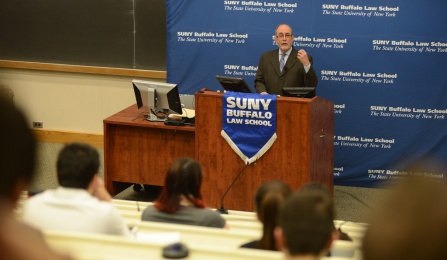Law Links - November 2014
A challenge to rethink homicide laws

Consider, said Joshua Dressler, two people who kill: a mother who, on a whim, throws her child from a bridge, and a son who carefully plans out the mercy killing of his terminally ill father. Which killer deserves the more severe punishment?
Intuition, he suggested, would say that the terrible act of the mother offends our collective moral sensibility more deeply than the son’s act of mercy. And yet, under the current legal framework that makes premeditation and deliberation the criteria for a first-degree murder conviction, the son would suffer the heavier weight of society’s disapproval.
That kind of thought experiment was what Dressler, a leading scholar of criminal law who teaches at the Moritz College of Law at Ohio State University, brought to SUNY Buffalo Law School in an Oct. 24 appearance.
The lecture was sponsored by the Buffalo Criminal Law Center and the student Criminal Law Society.
Dressler is at work on a book, tentatively titled Killing People, which rethinks the assumptions behind murder laws in the United States. In his address, he shared what he called “some tentative thoughts about how we might recodify our murder statutes.”
For example, he said, “Studies teach us that jurors, even if they want to follow the law, are often unable to understand and therefore follow the legalistic instructions they receive from judges. So I’m inclined to think that it would be wise to give juries fewer, not more, legalistically precise instructions on how to distinguish between different levels of murder, or murder and manslaughter. I’m talking about how we draft the statutes themselves, so jurors have considerable freedom to draw their own lines between the greater and lesser varieties of homicide.”
In addition to the problematic assumption that premeditation and deliberation are always more deserving of punishment than an unpremeditated killing, Dressler asked: “Is it clear that an intentional killing, even a premeditated and deliberative one, is always more deserving of punishment than an unintentional one?”
In response to that question, he proposed a scheme that preserves two degrees of murder, with the default charge being second-degree murder. He would define murder as “an intentional killing, or an unintentional killing committed under circumstances manifesting an extreme or depraved indifference to the value of human life,” with no mention of recklessness. The charge could be elevated to first-degree murder, he said, if aggravating factors were present, such as if the victim was particularly weak or vulnerable; if there were special circumstances in the motive, such as racism or homophobia; and if the method of killing was especially brutal, such as torture. No mitigating factors would be considered in this scheme, he said, “because a second-degree murder charge is its own mitigation.”
And Dressler argued forcefully for giving greater latitude to juries, saying that jurors represent the conscience of society. “A criminal conviction sends a message to the defendant and to the community about what the community considers acceptable and unacceptable behavior and what the person on trial deserves as punishment,” he said. “We cannot, nor should we, make criminal trials bloodless. It is wrong to think that emotions, including shock or disgust directed at the defendant’s conduct, can or should be deterred.”
